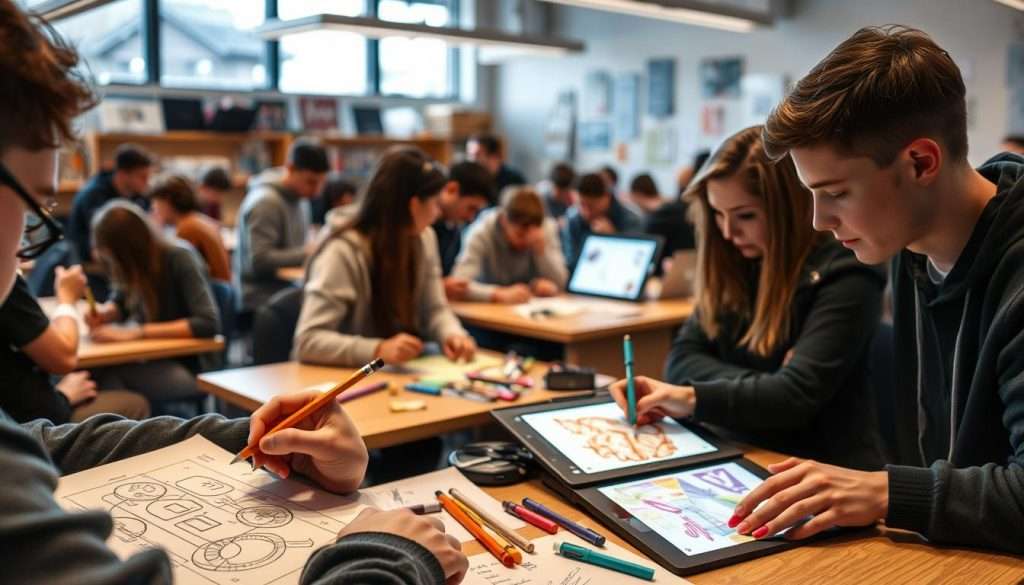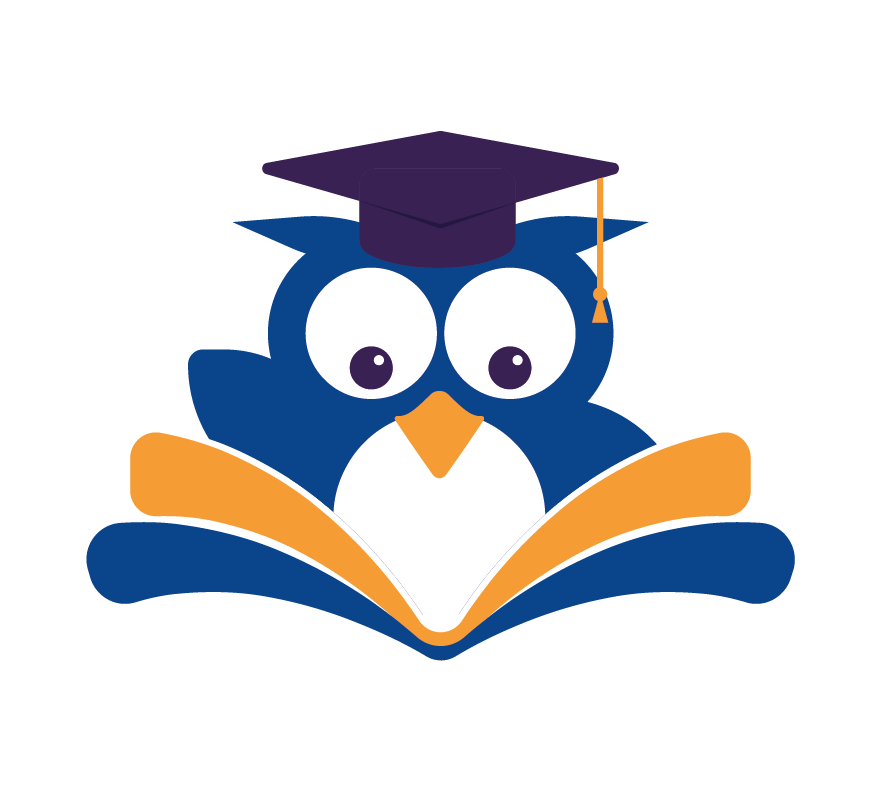Are you tired of the same old study routine? Creative thinking can be the game-changer you need to boost your academic performance. In today’s competitive academic world, simply memorizing facts isn’t enough; you need to think outside the box to succeed.
We know that conventional study methods can be dull and ineffective. That’s where innovative learning strategies come in. By integrating creative thinking into your study routine, you can make learning more engaging and enjoyable. This approach not only enhances your understanding but also helps you retain information better.
You have the potential to achieve academic success by adopting a more creative and interactive way of learning. Let’s explore how you can outsmart the box and make your academic journey more rewarding.
Key Takeaways
- Creative thinking enhances academic performance.
- Innovative learning strategies make studying more engaging.
- Integrating creativity into your study routine improves retention.
- Adopting creative approaches can lead to academic success.
- Thinking outside the box is crucial in today’s competitive academic world.
The Power of Creative Thinking in Academic Success
Creative thinking is key to doing well in school. It lets students solve problems in new ways. This approach finds solutions that regular learning might miss.
How Creative Thinking Differs from Traditional Learning
Traditional learning focuses on memorizing and repeating. But creative thinking makes students question and explore. It makes learning fun and helps students think critically.
Why Schools and Universities Reward Innovative Problem-Solvers
Schools and universities want students who think differently. Innovative problem-solvers are great because they tackle tough challenges. They help with important research and projects. Creative thinking helps students stand out and do better in school.
Understanding Your Brain’s Creative Potential
Your brain is incredibly creative. Knowing how it works can unlock that potential. It’s a master at recognizing patterns, which boosts your creative thinking.
Our brains use two main ways to think: automatic and manual. Automatic thinking is quick and instinctive. Manual thinking is slower and more thoughtful. Learning to switch between these modes can help you come up with new ideas and solve tough problems.
The Neuroscience of Creative Insights
Neuroscience shows that creative insights come from different brain parts working together. The default mode network, which handles daydreaming, is key in creating new ideas.
When you’re relaxed and not focused, your default mode network kicks in. It connects unrelated ideas, leading to breakthroughs and new solutions.
Activating Different Thinking Modes for Academic Tasks
To switch thinking modes, try different techniques. For example, taking breaks and doing things that spark your default mode network can spark creativity.
| Thinking Mode | Characteristics | Academic Tasks |
|---|---|---|
| Automatic | Fast, instinctive, intuitive | Multiple-choice questions, routine problems |
| Manual | Slow, deliberate, analytical | Complex problem-solving, essay writing, research papers |
By understanding your brain’s creative power and learning to switch thinking modes, you can do better in school. You’ll find a smarter way to learn.
Outsmart the Box: Creative Thinking Tricks to Skyrocket Your Grades
Outsmarting the box in school means using new ways to learn. To get better grades, try creative thinking tricks. These make learning fun and more effective.
Breaking Down the “Box” in Academic Thinking
Old school thinking can make learning feel stuck. But, using tricks like mind mapping and brainstorming can set you free. These methods help you think of many ways to solve a problem.
For example, instead of just writing an essay, try making a mind map. It helps you see how different ideas are connected. This way, you learn more and remember it better.
Real Student Success Stories: Before and After Creative Thinking
Many students have gotten better grades by thinking creatively. Here are a few stories:
| Student | Before Creative Thinking | After Creative Thinking |
|---|---|---|
| Alex | C+ in History | A- after using mind maps for essay planning |
| Maya | B- in Science | A after applying brainstorming techniques for project ideas |
By using creative thinking, you can really boost your grades. It’s a smart way to succeed in school.
Divergent Thinking Techniques for Better Assignments
Imagine coming up with many creative ideas for your assignments quickly. That’s what divergent thinking can do. It helps you think of lots of ideas and solutions, which is great for complex tasks. Using these techniques can help you overcome mental blocks and find new ways to do your work.
SCAMPER Method for Essay Topics and Arguments
The SCAMPER method is a way to think of new ideas by looking at old ones in new ways. SCAMPER means Substitute, Combine, Adapt, Modify, Put to Another Use, Eliminate, and Rearrange. It helps you come up with new arguments and ideas for your essays.
Mind Mapping to Connect Complex Concepts
Mind mapping is a visual way to link different ideas together. It lets you organize your thoughts and see how they’re connected. This is really helpful for assignments that need you to mix together lots of information.
Random Word Association for Breaking Mental Blocks
At times, a random word can spark your creativity. Random word association is when you think of a random word and then connect it to your assignment. It’s a great way to get past mental blocks and find new ideas.
Adding these divergent thinking methods to your study routine can make your assignments more innovative and effective.
Convergent Thinking: Turning Creative Ideas into A-Grade Work
Convergent thinking is key to making your creative ideas shine in your assignments. It narrows down ideas to create clear, structured work. This is vital for making your academic work stand out to your teachers.
Six Thinking Hats Method for Research Papers
The Six Thinking Hats method by Edward de Bono is great for convergent thinking. It lets you see a topic from different angles. This way, you get a full view of your research topic.
It helps you organize your thoughts and evaluate information better. This leads to well-rounded research papers.
The Ladder of Abstraction for Refining Arguments
The Ladder of Abstraction helps you move between specific details and big ideas. Climbing the ladder makes your arguments more universal. Going down the ladder adds concrete examples to support your points.
This method is crucial for making your essays and research papers stronger.
Synthesis Matrices for Literature Reviews
Synthesis Matrices are perfect for organizing literature reviews. They help you compare and contrast studies. This way, you can spot patterns and understand the research better.
They turn literature reviews into deep analyses, not just summaries.
As “The art of thinking is so far beyond the art of memory” by John Dewey shows, convergent thinking can be learned. Using these techniques will help you create top-notch, A-grade work.
Subject-Specific Creative Approaches
Creative thinking varies by subject. To do well in your studies, use creative strategies that fit your field.

Mathematics and Science: Visualization and Analogy Techniques
In math and science, visualization is key. Try to see complex ideas as diagrams or graphs. For example, seeing the area under curves helps grasp integration in calculus.
Analogy techniques also help. Think of an atom like our solar system. It makes remembering its parts and how they work easier.
Humanities: Perspective-Shifting and Empathetic Analysis
In humanities like history or literature, perspective-shifting is crucial. Look at texts or events from different angles. For example, when studying a historical event, see it from the viewpoints of various nations or groups.
Empathetic analysis is also valuable. When reading, try to understand characters’ feelings and reasons. It makes the story richer.
Arts and Design: Constraint-Based Creativity Methods
In arts and design, constraint-based creativity works well. Setting limits, like a certain color palette or shapes, can spark new ideas. It leads to unique art.
Using these creative methods for your subject can improve your learning and grades.
Creative Study Methods That Stick
Studying doesn’t have to be dull. There are many creative ways to make it interesting. By adding creativity to your study routine, you can learn better and remember more. Let’s look at three cool techniques that can change how you study.
The Memory Palace Technique for Fact Retention
The Memory Palace method, also known as the method of loci, is very old. It uses a familiar place and links the info you want to remember to spots in that place. For example, to remember historical dates, imagine walking through your house and placing each date at a different spot. This method uses your spatial memory to help you remember better.
Story-Based Learning for Sequential Information
Story-based learning turns facts into a story. It’s great for learning things in order, like history or science. By making facts into a story, you can remember them more easily. For instance, you could tell a story about a character who goes through different chemical reactions.
Visual Note-Taking Systems for Visual Learners
Visual note-taking uses pictures and charts to capture info. It’s perfect for people who learn better with images. Methods like mind mapping and sketchnoting help organize and review material. Adding pictures makes your notes more fun and easy to remember.
| Study Method | Description | Benefit |
|---|---|---|
| Memory Palace | Associating information with locations in a familiar space | Enhances spatial memory and recall |
| Story-Based Learning | Creating narratives that incorporate information to be learned | Makes sequential information more memorable |
| Visual Note-Taking | Using diagrams and illustrations to capture information | Engages visual learners and enhances organization |
Presenting Your Creative Ideas Effectively
The art of presenting creative ideas is about mixing innovation with clarity. In a crowded academic world, it’s not just about having a great idea. It’s how you present it that matters.
Structuring Creative Arguments for Traditional Assessments
When working in traditional settings, frame your ideas in a way that grabs attention and is solid academically. Use clear, simple language and back up your points with evidence.
For example, in an essay, organize your thoughts and evidence in a table. Here’s how:
| Idea | Evidence | Analysis |
|---|---|---|
| Creative thinking enhances problem-solving skills | Studies show that creative thinking training improves academic performance | This suggests that adding creative thinking to our curriculum could help students more |
| Innovative learning methods boost student engagement | Research shows interactive learning increases student motivation | So, using new learning methods could make students more engaged and motivated |
When to Push Boundaries vs. When to Play It Safe
Knowing when to be bold and when to play it safe is key. Pushing boundaries can lead to new discoveries, but it can fail if not done right.
So, when should you take a risk? Think about the situation and what your idea could do. For small assignments, trying something new might be okay. But for big tests, it’s safer to mix creativity with traditional methods.
Convincing Skeptical Professors of Your Creative Approach
Some professors might doubt new ideas. To win them over, show the value and rigor of your creative approach. Use evidence, logic, and clear explanations to prove your idea is both new and solid.
By structuring your ideas well, knowing when to be bold, and convincing tough professors, you can present your creative ideas effectively. This can lead to success in your studies.
Overcoming Creative Blocks and Academic Anxiety
We’ve all faced the blank page stare, feeling trapped by school pressure. But, there are ways to break free. Creative blocks and school stress can slow you down, but you can beat them with the right methods.
Recognizing and Breaking Through Mental Barriers
The first step is to spot the mental walls holding you back. These might be fear of failure, needing to be perfect, or feeling too overwhelmed. Once you know what’s stopping you, you can start to find ways to get past it.
Breaking down big tasks into smaller ones can make them feel less scary. This lets you focus on one thing at a time. Also, setting aside time just for brainstorming can spark your creativity.
Structured Procrastination and Incubation Periods
Structured procrastination might seem odd, but it can work. By doing less important tasks first, you might make progress on the big one. Also, taking breaks and letting your subconscious work on a problem can lead to new ideas when you come back.
For example, going for a walk or doing something you love can refresh your mind. When you return to your task, you might see it in a new light.
Mindfulness Techniques for Academic Creativity
Mindfulness, like meditation and deep breathing, can lower school stress and boost creativity. It helps you stay calm and focused on your work.
Here are some mindfulness techniques to try:
| Mindfulness Technique | Description | Benefit |
|---|---|---|
| Meditation | Sitting quietly, focusing on your breath | Reduces stress, improves focus |
| Deep Breathing | Conscious, slow breathing exercises | Calms the mind, reduces anxiety |
| Body Scan | Lying down or sitting, focusing on body sensations | Relaxes the body, reduces tension |
By using these strategies, you can beat creative blocks and school stress. It’s about making progress, not being perfect.

Collaborative Creativity: Elevating Group Work
In group projects, collaborative creativity is key to success. When students share their unique views and skills, they can do more together than alone.
Brainwriting Instead of Brainstorming
Brainwriting lets everyone write down ideas, not just shout them out. This way, everyone gets a chance to share, and no one voice is too loud.
Rolestorming for Perspective-Shifting in Teams
Rolestorming means team members play different roles to see problems from new angles. It sparks creativity and keeps teams from getting too stuck in one way of thinking.
Digital Tools for Asynchronous Creative Collaboration
Digital tools are crucial for teamwork in remote learning. Slack, Trello, and Miro help teams brainstorm and organize ideas, even when they’re apart.
| Technique | Description | Benefits |
|---|---|---|
| Brainwriting | Contribute ideas in writing | Equal participation, reduced dominance by a single voice |
| Rolestorming | Take on different roles or personas | Encourages creative thinking, avoids single mindset |
| Digital Tools | Use platforms for asynchronous collaboration | Facilitates remote teamwork, organizes ideas effectively |
Using these techniques, students can tap into the power of teamwork. This way, they can reach their full potential and succeed in school.
Building a Personal Creativity System for Academic Success
Cultivating creativity is more than just finding inspiration. It’s about creating a system that works for you. To succeed in school, you need a personal creativity system that boosts your innovative thinking and problem-solving skills.
Daily 10-Minute Creative Thinking Exercises
Begin with easy exercises like free writing or brainstorming. Use a timer for 10 minutes and write down as many ideas as you can on a topic. This helps loosen your thinking and gets your creative juices flowing.
Weekly Creative Review and Reflection Process
Make time each week to look back at your progress. Reflect on what’s working and adjust your approach if needed. This reflection process is key to refining your creativity system and keeping it effective.
Creating a Personalized Creativity Toolkit
Build a toolkit with resources and techniques that fit your learning style. This could include mind mapping software, creativity apps, or a journal for jotting down ideas.
| Tool | Purpose | Benefit |
|---|---|---|
| Mind Mapping Software | Visual organization | Enhances idea connection |
| Creativity Apps | Idea generation | Provides prompts and exercises |
| Journal | Reflection and tracking | Helps in identifying patterns |
By adding these elements to your daily and weekly routine, you’ll build a strong personal creativity system. This system will support your academic success.
Conclusion: Creative Thinking as Your Competitive Edge
Creative thinking is a powerful tool that can change your academic journey. By using different techniques, you can solve problems and come up with new ideas. This includes divergent thinking methods and convergent thinking strategies.
Improving your creative thinking skills gives you an edge in school. You’re not just doing homework; you’re learning to think outside the box. This skill is key in today’s fast-paced schools, where being original can really set you apart.
We urge you to keep working on your creative thinking. As you do, you’ll see better grades and develop skills that last a lifetime. So, keep exploring new ideas and watch your grades soar.

